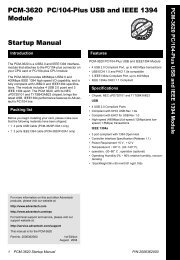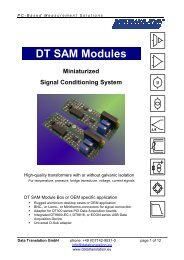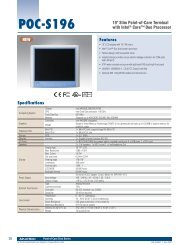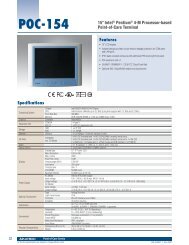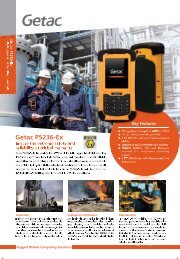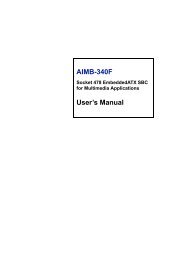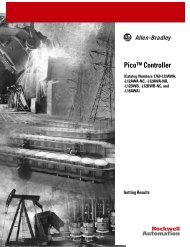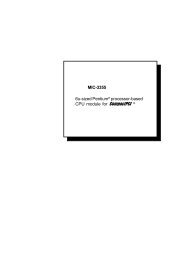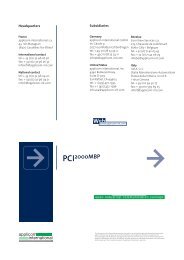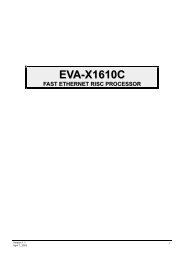1747-6.22, Backup Scanner User Manual
1747-6.22, Backup Scanner User Manual
1747-6.22, Backup Scanner User Manual
You also want an ePaper? Increase the reach of your titles
YUMPU automatically turns print PDFs into web optimized ePapers that Google loves.
Bit Number Octal 17 10 7<br />
Bit Number Decimal 15<br />
8 7<br />
Logical<br />
Rack 0<br />
Word 0<br />
Word 1<br />
Word 2<br />
Word 3<br />
Word 4<br />
Word 5<br />
Word 6<br />
Word 7<br />
Primary I/O Image<br />
0<br />
0<br />
RIO Block Transfer 7-121<br />
Below are points to consider when implementing BT operations:<br />
• The minimum amount of scanner image that can be assigned to a<br />
device on the RIO link is 1/4-logical rack in the G file<br />
configuration. This allows up to four separate devices per logical<br />
rack. Each device could have a maximum of four BTs configured<br />
to it. Thus, up to 16 BTRs and/or 16 BTWs could be assigned to<br />
each logical rack.<br />
• If a BT device is a <strong>1747</strong>-ASB RIO Adapter, then multiple SLC<br />
500 modules (such as analog modules) could be scanned by the<br />
<strong>1747</strong>-ASB and the data block transferred to the RIO scanner.<br />
Since the RIO network handles one BT request per logical rack<br />
at a time, there will be a delay before all devices in the <strong>1747</strong>-<br />
ASB rack can be accessed. Therefore you should only perform<br />
BTs as necessary (i.e., “on demand”).<br />
• Inhibiting a device on the RIO network (via control words<br />
M0:e.8...11) precludes that device from block transfer<br />
operations. Attempting to initiate a BT to an inhibited device<br />
results in an error reply. The scanner cancels a BT that is in<br />
progress if it detects that the device is inhibited. Because of the<br />
asynchronous nature of inhibiting a device that has a BT in<br />
progress, the BT reply may indicate either a successful<br />
completion or an error. In either case, the SLC control program<br />
must still clear the Enable flag.<br />
• All M0 and M1 BT buffers are cleared (set to all zeros) after a<br />
power cycle and when the SLC processor goes from Program to<br />
Run mode, Program to Test mode, or Test to Run mode.<br />
When using complementary I/O, if you configure a complementary<br />
device to use more I/O image space than an associated primary<br />
device, then block transfers can only be performed to locations in the<br />
complementary device that have associated I/O image space in the<br />
primary device. For example, if a primary device is 1/2 logical rack<br />
and a complementary device is a full logical rack, block transfers can<br />
be performed only in the first 1/2 logical rack of the complementary<br />
device. Attempting block transfers in the last half of the<br />
complementary device results in a BT error (error - 11 - device not<br />
configured).<br />
1/2 logical rack<br />
configured and usable<br />
1/2 logical rack not<br />
configured<br />
Bit Number Octal 17 10 7<br />
Bit Number Decimal 15<br />
8 7<br />
Word 0<br />
Word 1<br />
Word 2<br />
Word 3<br />
Word 4<br />
Word 5<br />
Word 6<br />
Word 7<br />
Logical<br />
Rack 8<br />
Complementary I/O Image<br />
0<br />
0<br />
1/2 logical rack configured<br />
and usable<br />
1/2 logical rack configured, but<br />
not usable for BT since Words<br />
4-7 are not configured for the<br />
primary device.<br />
Publication <strong>1747</strong>-<strong>6.22</strong>




